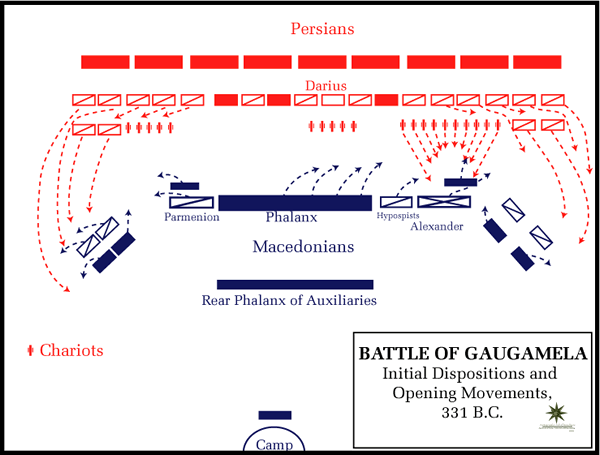The Battle of Gaugamela is one of the lesser known battles between two famous leaders and Empires of ancient times. The Battle of Gaugamela occurred on the 1st October 331 BC and was a battle between Alexander the Great of Greece and Darius III of Persia.

Interestingly many people don’t know of the Battle of Gaugamela, yet this battle was probably the most decisive of battles between the Greek and Persian Empires.
Historical records of the battle don’t show the strength of the Greek army under Alexander the Great although estimates are around 47,000. The Persian army was an immense mass of between 53,000 and 100,000 men (modern estimates).
Prior to the Battle of Gaugamela
In the years leading up to the battle Alexander the Great had made huge strides in taking over Persian lands. This all started around two years before when the Greeks and Persians faced one another at the Battle of Issus, a battle that the Persians lost.
After the Battle of Issus Alexander continued moving deeper in to Persian territory as far as present day Iraq, he did this by crossing the Euphrates River and Tigris River. It is near the present day city of Mosul in northern Iraq that the battle took place.
The Battle of Gaugamela
The battle position was dictated by the Persians who were already in force on a plain without vegetation. The idea for this was to make a flat and unhindered passage for his chariots to wreak havoc on the Greek forces.
As usual the Persian Darius III placed himself in the centre of his army while Alexander split his army into two with Alexander on the right side of the Greek force; this was a mirror image of the stance both took at the Battle of Issus.
The Greeks were the first to engage in battle as they marched forward to the central line of the Persians in the trademark attack of the Greeks, the Phalanx.
As this happened Alexander unleashed a master strategy that must have confused the Persians. Alexander gathered his cavalry and rode them over to the right drawing the cavalry of the Persian ranks over to attack him. The idea behind this move was to open a gap in the Persian line as they moved across to the right; this would require delicate timing to ensure it worked well.
Darius attacked Alexander after being pushed into a position where he had too. The first action by Darius was to launch his chariots, a weapon that was once devastating but the Greeks had a plan and using spears managed to attack and kill both horse and riders at will.
The Persians continued attacking and filtering further into the Greek lines, it was at this point that Alexander launched his massive strategic attack. Alexander pushed a large group of his right flank as a wedge into the rear of the Persians line, basically cutting them off and forcing them to fight on two fronts. This wedge was so successful that Alexander was able to attack the central units of Darius army; this caused Darius and one of his Generals to turn and run with their army following behind.
While Alexander could have followed he returned to support his General Parmenion on the left flank who had took the brunt of the Persians advances and required support.
This battle ended with the Greek forces of Alexander being victorious, it was such a success that Alexander was able to conquer half of Persia.
It is said that the Persians lost 40,000 men with Greek losses only standing at 4,000.
